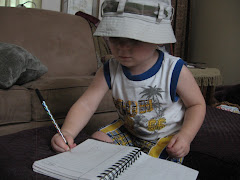1. Paulsen, Gary. Notes from the Dog. New York: Wendy Lamb Books, 2009.
2. Plot Summary. Fourteen-year-old Finn is looking forward to the summer when he won't have to talk to anyone. He has set a goal of talking to no more than a dozen people for the entire summer break, with a life goal of getting a job where he doesn't have to talk to anyone. He just doesn't feel comfortable with people. And then Johanna, a college student, moves in next door to housesit for the summer. She hires Finn to plant a garden, and suddenly he is talking to people left and right, much to his consternation. However, Johanna has breast cancer, and as she trains to participate in a triathlon geared to raise money for breast cancer research, Finn begins to realize how important people really are to living a fulfilled life.
3. Critical Review. Gary Paulsen is king of the adventure story for Young Adults. When I think of Paulsen, I think of stories that are set in the wilderness with one of the major conflicts being man vs. nature. Notes from the Dog is one of his novels that does not fit in this category, though there is a dog. Finn lives in the suburbs, and his dog is a border collie who starts bringing Finn notes such as, "You're not as ugly as you think." Finn figures out quickly the notes are from Johanna and is surprised to realize later, after he receives the fifth and last one, that they have had a positive effect on his self-confidence.
I found the handling of the cancer part of the story to be sensitively done; however, I also thought it was handled somewhat unrealistically with Johanna being almost too upbeat all the time. Yet she does have issues with nausea (she throws up all over Finn and his buddy Matthew after one of her chemo treatments), and she's obviously ill as Finn notices how thin and pale she is along with the fact that they discover her red hair is actually a wig. A review in VOYA agrees when the reviewer says, "in this book, the dialogue and story line seem a little too pleasant and the lives of the teens lack any real angst or conflict outside the horrors of Johanna's chemo side effects." The same reviewer makes a note of the fact that this book is written for boys and states, "Given the brevity of the book and its inclination to be a book for boys, it could be recommended to reluctant readers." Brief it is. At 132 pages, this is an easy read that might appeal to middle school readers - both boys and girls. The characters are in junior high, and have the feeling of being younger than high school, and the conflict is definitely light. Finn's journey from self-proclaimed loner to integrated member of a budding community lacks the emotional conflict that most 14-year-olds endure when they are experiencing an upheaval of their world.
Nevertheless, this book is Paulsen, and I have yet to read a Paulsen novel that disappoints. Matt Campbell, Grade 8, describes reading Gary Paulsen novels in this way, "While reading Gary Paulsen's books I get the feeling that he shares my feelings about animals. I enjoy reading his books so much because of how he describes everything, and makes you feel like you are the main character."
(http://comminfo.rutgers.edu/professional-development/childlit/paulsen1.html) I find this to be true of all of the Paulsen novels I have read. The characters are well-developed, and it is easy to find myself lost in the plots, often unwilling to put the book down until I have finished it. However, for readers who love Paulsen for novels such as Hatchet and the Brian books, The Foxman, or Dogsong, this novel may feel just a little too "tame." But for experienced Paulsen readers who understand at the outset that this story will be a different type of adventure, Notes from the Dog will provide a stepping stone to enjoying the eclectic mix of excellent stories Gary Paulsen creates.
4. Review Excerpts
Publishers Weekly: "The plot is straightforward, but Paulsen's thoughtful characters are compelling and their interactions realistic. This emotional, coming-of-age journey about taking responsibility for one's own happiness and making personal connections will not disappoint."
Children's Literature: "Gary Paulsen has written another treasure, but the challenge this time is not weather or wildlife but befriending a young woman with cancer."
School Library Journal: "Paulsen's fans may miss his trademarks: the notorious exploits of boys, the page-turning wilderness adventures, or the sled dogs that often take center stage. Yet this candid and tender tale, told with his signature humor, is a salute to the bravest of the brave."
GUEST POST: Chris Baron on SPARK
8 months ago






